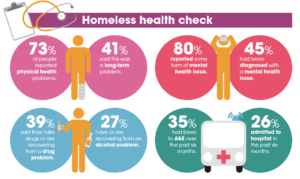Housing need
 The Housing Board works with partners to identify and meet housing need, extend housing choice and tackle homelessness. The Board wants to help people find – and settle into – a home which is good quality, affordable and meets the household’s needs. Board members work with a wide range of partners to prevent and tackle homelessness, aiming to make homelessness the unacceptable outcome; to reduce deprivation and to improve social inclusion.
The Housing Board works with partners to identify and meet housing need, extend housing choice and tackle homelessness. The Board wants to help people find – and settle into – a home which is good quality, affordable and meets the household’s needs. Board members work with a wide range of partners to prevent and tackle homelessness, aiming to make homelessness the unacceptable outcome; to reduce deprivation and to improve social inclusion.
The local picture
What data do we have and use to analyse housing need and homelessness across our housing market area?
Strategic Housing Market Assessment
Our strategic housing market assessment looks at a wide range of housing issues across seven districts. Please visit this page to find out more about our SHMA, and updates on objectively assessed need for housing.
Joint Strategic Needs Assessments
- Partners worked together to assess the needs of homeless people, and those at risk of homelessness, in our area. The joint strategic needs assessment is available here.
- A JSNA which explains links between housing need and wellbeing is the Health and Housing JSNA, published 2013.
Atlases and open data
- Sub-region parish profiles set out housing supply and demand data for parishes. A partner atlas, Sub-regional ward profiles looking at wards rather than parishes. To download a print-friendly spreadsheet version of the profile data in excel, please click here. You can also explore the housing needs register applicant parish preference, social rent lettings and bidding behaviour here in open data format, with a data story here
- Changes in housing affordability are published in open data format here, drawing together some data gathered for the housing market assessment.
- Homelessness statistics are published as Open Data here.
- An experimental directory of local services in Cambridge, based on Foodbank listings of services in July 2018 is published in open data format, with a map, here. This was a fore-runner of Street Support Cambridge (see below).
Resources
You can find links to local homelessness strategies, tenancy strategies and tenancy policies here.

Homeless Link published its health audit report 2014 here: The unhealthy state of homelessness. This provides some very useful facts, examples of good practice and recommendations.
The Government held an inquiry into the implementation of the Homelessness Reduction Act, one year on. The Housing Board has produced a note summarising the three hearings and 134 questions asked.
In November 2018 It Takes a City held a summit with numerous partners from the local community and businesses. The projects coming out of the Summit are summarised on It Takes a City’s homepage.
One of the projects which launched in October 2019, was securing and using a new website and app called Street Support Cambridge. This provides information in a variety of mobile-friendly formats about services for homeless people in Cambridge; and for residents and local businesses to identify ways they can help by giving time, money or donations.
The duty to refer
Many public agencies now have a legal duty to refer someone who is homeless, or may become homeless, to a homelessness team. This is call the the Duty to Refer.
We are creating notes on the duty, to help partners in referring agencies find a quick link to each housing team who accept the referrals.
Our first note focuses on partners in the main local hospitals: How to get help if someone preparing to leave hospital is homeless.
Protocols
These protocols set out partners “ways of working” together when specific issues arise. They seek to smooth the pathway for people facing a number of issues in their lives, and to make sure partners work together to help and support them.
Protocol for 16 and 17 year olds who are homeless
Here is a link to a protocol to help tackle the housing needs of homeless 16 and 17 year olds across Cambridgeshire 2018 protocol for homeless 16 and 17 yr signed. It is signed by Cambridgeshire County Council, Cambridge City Council, East Cambridgeshire, Fenland, Huntingdonshire and South Cambridgeshire District Councils.
Criminal Justice protocol “Pathways home”
Housing and criminal justice partners are working together, with support from the Police and Crime Commissioner, to agree how best to work together as part of the Trailblazer project. A workshop was held in 2018 which resulted in this report in May 2018. Further work led partners to update the protocol (initiated in January 2017) with accompanying slides. The protocol is now being embedded and promoted with partners across the system.
Multi Agency Public Protection Arrangements (MAPPA) Protocol for Housing High Risk of Serious Harm Offenders
Published in May 2017, the MAPPA protocol can be accessed using this link.
Hospital discharge protocols
- Addenbrooke’s
- Hinchingbrooke
- Peterborough
- Fulbourne
Housing, mental health and substance misuse toolkit
Please see this page for more on the Toolkit, published in 2023
Good practice guidelines for agencies working with victims, survivors and/or perpetrators of domestic abuse who also use alcohol and drugs
Please follow this link to find the domestic abuse and substance misuse guidelines, published April 2021
supporting people with No Recourse to Public Funds
This protocol was published in 2021, please click here to open the document and here to read a little about the protocol.
Hoarding
Published in 2016, this protocol helps partners work together when someone is hoarding. Please click here for the protocol and visiting this page for more background and guidance.
Joint Housing Protocol for Care Leavers
This protocol was updated in 2023, and can be accessed here Joint Housing Protocol for Young People Leaving Care 23-24 final
Partners
Home-Link
In 2006 the seven districts in our local area launched Home-Link, a system to help people choose the home they would live in, rather than being ‘allocated’ a home by the local authority.
The idea is that people are more engaged in the decision of where to live; have more control over what kind of home and location they would settle best in; and would bid for, and eventually move to, a home and an area they wanted to settle in.
Choice does not increase the supply of homes available. It can still take a long time to find and successfully bid for a property. The process (briefly) is:
- Home-Link advertises available council and housing association homes across the local area, on-line every 2 weeks.
- Existing council and housing association tenants who wish to transfer to a different property and new applicants seeking a home can use the system to see the homes coming up for let.
- They then decide whether they want to be considered for any of the properties. If yes, they express an interest by making a ‘bid’. People can get help with bidding if needed by approaching their council or housing association.
- Home-Link offers choice about where people want to live and gives a clear picture of the housing available across our local area. The system gives feedback on previously advertised homes, to show the level of housing need of the successful bidder and how long they had been waiting.
Everyone registering on Home-Link is put in a ‘band’ summarised as Band A urgent need, Band B high need, Band C medium need, and Band D. To find out more please visit Home-Link.
Town Hall Lettings
Town Hall Lettings was formed in January 2014, responding to the needs of local landlords and the needs of people seeking accommodation. The team discovered that landlords  might be nervous of renting properties to people on low incomes. They wanted assurances that rent would be paid on time, that tenants would be suitable and that their properties would be treated with respect.
might be nervous of renting properties to people on low incomes. They wanted assurances that rent would be paid on time, that tenants would be suitable and that their properties would be treated with respect.
People struggle to find somewhere to live because they had an unproven tenancy history, they couldn’t provide a guarantor, or they could not find accommodation whilst out of work. Affordable accommodation was incredibly difficult to find – and the quality of available accommodation was often poor. So Town Hall Lettings was formed – a social lettings service – providing good quality, local, affordable accommodation to people who needed it – and providing a deal to landlords that would make good financial sense.
Since 2014 the service has grown and expanded, working with some great local landlords and helping turn people’s lives around as a result of being housed. Town Hall Lettings is looking for good-quality homes for families, single people and house-sharers in Cambridge and the surrounding areas. To find out more please visit the Town Hall Lettings website.
Own your own home
 In 2015 the government launched a new web resource called Own Your Own Home.
In 2015 the government launched a new web resource called Own Your Own Home.
It aims to help people “discover all the schemes that could make your dream of owning your own home a reality”.
Help to Buy
 “If you want to purchase a home of your own, but can’t afford to buy on the open market, Help to Buy could be your way onto the property ladder. The Government has created the Help to Buy scheme to help you take your first steps into home ownership. There are a number of Help to Buy products designed to make buying a home more affordable. You can buy a home using one of the home ownership options, or rent a home at less than the market rent, allowing you to save for a future deposit.”
“If you want to purchase a home of your own, but can’t afford to buy on the open market, Help to Buy could be your way onto the property ladder. The Government has created the Help to Buy scheme to help you take your first steps into home ownership. There are a number of Help to Buy products designed to make buying a home more affordable. You can buy a home using one of the home ownership options, or rent a home at less than the market rent, allowing you to save for a future deposit.”
This link takes you to the Help To Buy website.
Homelessness trailblazer partnership
In 2016, a whole range of partners across Cambridgeshire and Peterborough came together to bid for “homelessness trailblazer” funding. Happily, we secured nearly £750,000 as a result. You can find out more here.
Housing against domestic abuse
 The Housing Board is pleased to be working with partners at Cambridgeshire and Peterborough’s Domestic Abuse and Sexual Violence Partnership, set up to “reduce the harm, risk and costs associated with domestic abuse and sexual violence, and to prevent these crimes occurring across Cambridgeshire”; and with at the Domestic Abuse Housing Alliance to support and promote its work across our area to equip teams with new skills and approaches, which you can find out more about here.
The Housing Board is pleased to be working with partners at Cambridgeshire and Peterborough’s Domestic Abuse and Sexual Violence Partnership, set up to “reduce the harm, risk and costs associated with domestic abuse and sexual violence, and to prevent these crimes occurring across Cambridgeshire”; and with at the Domestic Abuse Housing Alliance to support and promote its work across our area to equip teams with new skills and approaches, which you can find out more about here.
